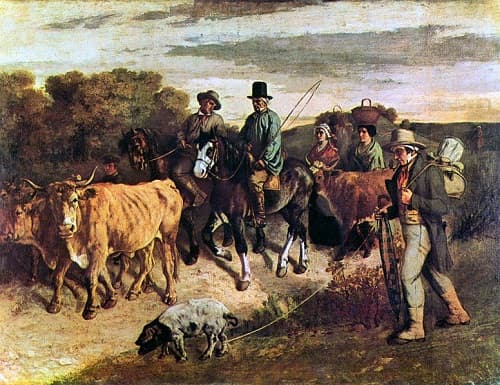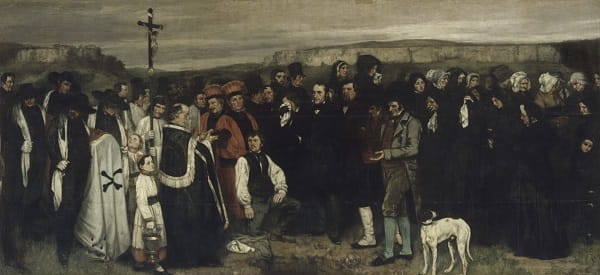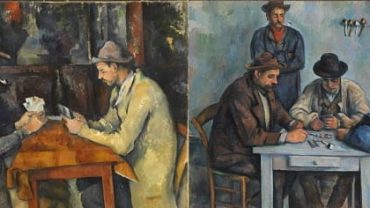Realism Art Movement
The Realism art movement emerged in the mid-19th century as a powerful reaction against the romanticized and idealized depictions prevalent in art.
Realist artists sought to portray the world as it truly appeared, free from embellishments or fantastical elements. With meticulous attention to detail, Realism aimed to capture life’s essence with exquisite precision. This approach brought a refreshing authenticity to the art world and allowed viewers to connect with artworks on a profound and relatable level.
Realism Art Movement: Capturing Life with Remarkable Detail
Realism Art Movement: Origins and Historical Context
The Realism art movement found its origins in the social, political, and industrial changes of the 19th century. As Europe underwent significant transformations due to the Industrial Revolution and the rise of capitalism, artists began to question the traditional artistic conventions that had prevailed for centuries. They sought to break free from the idealized and romanticized depictions of the past and instead present a more accurate and honest portrayal of the world around them.
One key factor that influenced the emergence of Realism was the advent of photography. The invention of the camera allowed for the precise and objective documentation of reality, challenging artists to find new ways to distinguish themselves. Rather than competing with photography, Realist artists embraced its influence and incorporated its principles of observation and attention to detail into their own works.

Farmers of Flagey on the Return from the Market, 1850 by Gustave Courbet – Realism Art Movement.
Realism also emerged as a response to the prevailing artistic movements of the time, such as Romanticism. While Romanticism emphasized imagination, emotion, and idealized landscapes, Realism sought to depict the world as it truly appeared, devoid of romantic embellishments. Realist artists aimed to capture the unvarnished truth of everyday life, showcasing the beauty and significance of even the most ordinary subjects.
In France, Gustave Courbet played a significant role in establishing Realism as a distinct artistic movement. His rejection of academic traditions and his commitment to portraying the realities of contemporary life set the stage for the Realist movement to flourish. Courbet famously stated, “I cannot paint an angel because I have never seen one,” encapsulating the Realist belief in representing what was observable and tangible.
Realism extended beyond France and had notable proponents in other countries as well. In Britain, artists like William Hogarth and the Pre-Raphaelite Brotherhood embraced Realist principles in their works. Similarly, in the United States, artists like Winslow Homer and Thomas Eakins depicted scenes of everyday life and the American landscape with remarkable precision.
By embracing the realities of their time and rejecting idealized notions of beauty, Realist artists challenged the established art world and paved the way for a new era of artistic representation. Their commitment to accuracy, observation, and capturing the essence of everyday life continues to influence and inspire artists to this day.
Key Characteristics of Realism Art
Realism is characterized by its meticulous attention to detail, accuracy in representation, and naturalistic techniques. The movement aimed to capture the world as it truly appeared, free from romanticized or idealized elements. Realist artists sought to portray their subjects with honesty and fidelity, emphasizing the ordinary aspects of everyday life.
One of the central tenets of Realism is the focus on accurate representation. Realist artists meticulously observed their subjects, paying close attention to every detail. They sought to faithfully reproduce the physical appearance of people, objects, and landscapes, often using techniques such as precise brushwork and subtle shading to achieve a convincing illusion of reality.
Realism also embraced the principles of direct observation. Artists ventured out of their studios to paint en plein air, capturing landscapes and scenes from life as they unfolded before them. This direct engagement with the world allowed Realist artists to capture the natural lighting, atmospheric effects, and nuances of their subjects with heightened authenticity.

Long Branch, New Jersey, 1869 by Winslow Homer – Realism Art Movement.
In addition to accuracy and direct observation, Realism emphasized a naturalistic approach to composition and perspective. Realist artists sought to portray scenes from everyday life in a manner that felt familiar and accessible to viewers. They often employed common pictorial techniques, such as the use of linear perspective, to create a sense of depth and three-dimensionality in their works.
Realism also challenged traditional artistic conventions by depicting a wide range of subjects, including those that were previously overlooked or considered unworthy of artistic representation.
Realist artists depicted ordinary people engaged in mundane activities, urban and rural landscapes, and still-life compositions. By elevating these seemingly unremarkable aspects of life, Realism brought a sense of dignity and importance to subjects that were often dismissed in art.

Portrait of Dr. Samuel D. Gross (The Gross Clinic), 1875 by Thomas Eakins – Realism Art Movement.
Through its meticulous attention to detail, accurate representation, naturalistic techniques, and diverse subject matter, Realism offered a radical departure from the idealized and stylized traditions of the past.
Realist artists sought to present a truthful reflection of the world, inviting viewers to engage with the authenticity of everyday life.
Notable Realist Artists and Their Masterpieces
Realism art was championed by numerous talented artists who made significant contributions to the movement. These artists created masterpieces that exemplify the meticulous attention to detail and honest representation that define Realism.
1- Gustave Courbet
Gustave Courbet, often regarded as the father of Realism, challenged academic traditions and championed a new approach to art. His masterpiece “A Burial at Ornans” (1849-1850) is a monumental painting that depicts a funeral scene in his hometown.

A Burial at Ornans, 1849-1850 by Gustave Courbet – Realism in Art.
The work is characterized by its meticulous attention to detail and its unflinching portrayal of ordinary people grieving, emphasizing the dignity and significance of their lives.
2- Jean-François Millet
Jean-François Millet is renowned for his empathetic depictions of rural life and the working class. His masterpiece “The Gleaners” (1857) portrays three peasant women stooping to gather leftover grain in a field.

The Gleaners, 1855 by Jean-François Millet – Realism in Art.
Recommended For You – Jean-Francois Millet’s The Gleaners Analysis
The painting highlights the hardships faced by rural workers and serves as a poignant commentary on social and economic inequality.
3- Winslow Homer
Winslow Homer, an American Realist artist, captured the essence of everyday life in his remarkable works. His painting “Snap the Whip” (1872) depicts a group of young boys engaged in a game, evoking a sense of joy, innocence, and camaraderie.

Snap the Whip, 1872 by Winslow Homer – Realism Arts.
Homer’s ability to convey emotion and the fleeting nature of childhood resonates strongly with viewers.
4- Honoré Daumier
Honoré Daumier, a French artist, and satirist, utilized Realism to make biting social and political commentaries. His lithograph series “Les Gens de Justice” (The Legal Profession) (1845-1848) satirizes the legal system and its officials with keen observation and incisive wit.

Les Gens de Justice (The Legal Profession Series) (1845-1848) by Honoré Daumier – Realism Arts.
Daumier’s works expose the follies and hypocrisy of the social order, showcasing the power of Realism as a tool for social critique.
Recommended For You – 8 Amazing Facts About Henri Matisse
5- William Hogarth
William Hogarth, an English painter, and printmaker, embraced Realism in his works that depict scenes of urban life. His series of engravings, “A Harlot’s Progress” (1732), presents a narrative of a young woman’s descent into prostitution.

A Harlot’s Progress, 1732 (Plate 5) by William Hogarth – Realism Art Movement.
Hogarth’s attention to detail, social commentary, and storytelling abilities showcase the influence of Realism in his art.
6- Thomas Eakins
Thomas Eakins, an American Realist painter, is known for his uncompromising dedication to accuracy and his deep exploration of human anatomy. His masterpiece “The Gross Clinic” (1875) portrays a surgical operation performed by Dr. Samuel D. Gross.

Portrait of Dr. Samuel D. Gross (The Gross Clinic), 1875 by Thomas Eakins – Realism Art Movement.
The painting is notable for its raw and realistic depiction of the medical profession, evoking a sense of intensity and intellectual rigor.
Realism’s Enduring Influence
Realism, with its dedication to portraying life with meticulous accuracy and honest representation, has left a profound and lasting impact on the art world. Its influence extends beyond the 19th-century movement itself and continues to shape artistic practices and perspectives today.
1- Direct Observation and Fidelity to Reality
Realism emphasizes the importance of direct observation and fidelity to reality. This commitment to observing the world with keen eyes and representing it truthfully influenced subsequent art movements, such as Naturalism and Impressionism.
Realism’s focus on capturing the effects of light, atmosphere, and everyday life laid the groundwork for these movements’ explorations of perception and the transient nature of visual experience.
2- Social Critique and Real-World Relevance
Realism’s dedication to representing the social realities of its time established a precedent for art as a powerful tool for social critique.
Realist artists tackled social issues, inequalities, and the impact of industrialization on everyday life. This commitment to addressing pressing societal concerns set a precedent for subsequent art movements, such as Social Realism, which continued to use art as a vehicle for raising awareness and advocating for change.
3- Influence on Photography and Visual Culture
Realism’s emphasis on accurate representation and capturing the essence of reality had a profound impact on the development of photography.
Realist artists embraced the principles of observation and attention to detail which were also central to early photographic practices.
The influence of Realism can be seen in the way photographers sought to depict the world with precision and authenticity, shaping the evolution of visual culture.
4- Continued Relevance and Appreciation
Realism’s ability to connect with viewers on a relatable and profound level has ensured its continued relevance and appreciation. Even in the contemporary art world, artists draw inspiration from Realism’s dedication to meticulous observation and truthful representation.
Recommended For You – What is Postmodern Art?
The timeless appeal of Realism lies in its ability to capture the essence of everyday life, evoking emotions, fostering empathy, and inviting viewers to engage with the world in a meaningful way.
The Realism art movement revolutionized the way artists approached their craft, championing authenticity, and capturing life’s essence in exquisite detail. By depicting everyday life with remarkable precision, Realism connected viewers to the shared experiences and emotions of humanity. Even today, Realism continues to inspire and influence artists, reminding us of the profound beauty that lies within the ordinary.
References:
- https://commons.wikimedia.org/wiki/File:Gustave_Courbet_002.jpg
- https://en.wikipedia.org/wiki/The_Stone_Breakers
- https://commons.wikimedia.org/wiki/File:Winslow_Homer_-_Long_Branch,_New_Jersey.jpg
- https://artsandculture.google.com/asset/portrait-of-dr-samuel-d-gross-the-gross-clinic/tQFcdDEg20osqg?hl=tr
- https://artsandculture.google.com/asset/a-burial-at-ornans/jwESwQ4qvb87oQ?hl=tr
- https://artsandculture.google.com/asset/the-gleaners/kwH07oo1QPMftQ?hl=tr
- https://artsandculture.google.com/asset/snap-the-whip/8gFMQMhl3fzS7Q?hl=tr
- http://cyrille.largillier.org/albums/daumier/
- https://en.wikipedia.org/wiki/A_Harlot%27s_Progress








